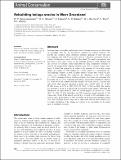Rebuilding beluga stocks in West Greenland
Abstract
Decisions about sustainable exploitation levels of marine resources are often based on inadequate data, but are nevertheless required for practical purposes. We describe one exception where abundance estimates spanning 30 years and catch data spanning more than 40 years were used in a Bayesian assessment model of belugas Delphinapterus leucas off West Greenland. The model was updated with data from a visual aerial survey on the wintering ground in 2012. Methods that take account of stochastic animal availability by using independent estimates of forward and perpendicular sighting distances were used to estimate beluga abundance. A model that appears to be robust to the presence of a few large groups yielded an estimate of 7456 belugas (cv = 0.44), similar to a conventional distance-sampling estimate. A mark–recapture distance analysis that corrects for perception and availability bias estimated the abundance to be 9072 whales (cv = 0.32). Increasing distance of beluga sightings from shore was correlated with decreasing sea ice cover, suggesting that belugas expand their distribution offshore (i.e. westward in this context) with the reduction of coastal sea ice. A model with high (0.98) adult survival estimated a decline from 18 600 (90% CI: 13 400, 26 000) whales in 1970 to 8000 (90% CI: 5830, 11 200) in 2004. The decline was probably a result of a period with exceptionally large catches. Following the introduction of catch limits in 2004, the model projects an increase to 11 600 (90% CI: 6760, 17 600) individuals in 2020 (assuming annual removals of 294 belugas after 2014). If the annual removal level is fixed at 300 individuals, a low-survival (0.97) model predicts a 75% probability of an increasing population during 2015–2020. Reduced removal rates due to catch limits and the more offshore, less accessible distribution of the whales are believed to be responsible for the initial signs of population recovery.
Citation
Heide-Jørgensen , M P , Hansen , R G , Fossette , S , Nielsen , N H , Borchers , D L , Stern , H & Witting , L 2017 , ' Rebuilding beluga stocks in West Greenland ' , Animal Conservation , vol. 20 , no. 3 , pp. 282-293 . https://doi.org/10.1111/acv.12315
Publication
Animal Conservation
Status
Peer reviewed
ISSN
1469-1795Type
Journal article
Description
This study was funded by the Greenland Bureau of Minerals and Petroleum, the Danish Cooperation of the Environment in the Arctic (DANCEA, Danish Ministry of the Environment) and the Greenland Institute of Natural Resources.Collections
Items in the St Andrews Research Repository are protected by copyright, with all rights reserved, unless otherwise indicated.

